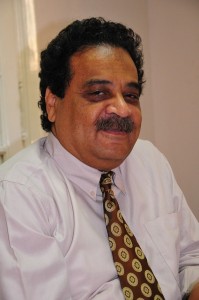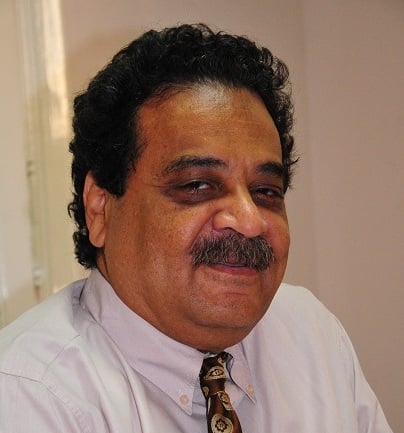
In previous articles, I went into detail regarding the three groups of the Islamist political movement: the political Islamist parties, at the heart of which is the Muslim Brotherhood; the religion-based political Islamist parties, at the heart of which is the Al-Nour party; and the radical Islamist parties, at the heart of which is the Al-Jamaa Al-Islamiya. Today, I will try to answer the question posed in the column’s title.
The three groups share a common framework, since they all claim that they only observe God’s law, and that their main references are the Quran and Sunnah. However, the members of the Muslim Brotherhood are mainly engrossed in the writings of Hassan Al Banna and Saiyyid Qutb. In addition, Salafis and members of Al-Jamaa Al-Islamiya focus on the writings of their own groups’ sheikhs and imams. Therefore, in each group, the Quran and Sunnah are read in a different way, and therefore explained in three different ways.
Consequently, the public often witnesses intellectual battles between the three different parties, and their respective readings, since each group claims that its interpretation is the only correct one. Often, each group would quote a verse of the Quran, or a saying of the Prophet to justify its position. Even though they usually quote the same text, they each reach a different conclusion. This complicates issues for the general public, who would often choose one group over the other based on the group’s social state or mood, rather than its readings or justifications. In addition, since the intellectual battle revolves around who is the most capable of speaking in the name of Islam, the other two groups become, by default, religiously incorrect. Moreover, the battle might reach the extent of inadvertently insinuating that the other groups are blasphemous.
In several instances, this framework has become a source of division rather than unity, since the different readings of the text recall feelings of annoyance, especially if it is related to issues of belief and blasphemy. To clarify, let us contemplate the relationship between the Marxist Leftist parties and their own framework. Even though all of the parties depend on Marxism as its own frame of reference, they do not consider it a “holy” text. Therefore, the parties do not argue on different readings of Marx’s texts, but they try to depend on the Marx methodology to deal with the new reality that faces them, and hence see the benefit of new ideas and new texts. Moreover, the parties depend on texts other than that of Marx: writers and thinkers such as Lenin, Luxemburg, Trotsky, etc. The political Islamist groups all depend on the same texts and none of them rely on majorly different ones such as those of Ibn Taymiyyah and Ibn Rushd. All of the three groups are greatly traditional and only depend on the Quran and Sunnah.
At the same time, depending on the writings of their own sheikhs does not prove each group’s correctness. Therefore, the only accepted frame of reference in any intellectual discussion remains the Quran and Sunnah. In the case of the Muslim Brotherhood, what comes first are the Quran and Sunnah, closely followed by the writings of Al Banna and Sayyid Qutb, and then thirdly the writings of other imams and sheikhs of the Brotherhood. The same goes for the other two groups, but with their own thinkers and sheikhs. Therefore, discussions between the three groups usually reach an impasse, since none can quote its own sheikhs and thinkers to prove its point. Hence, given that they cannot argue on the readings of texts, the discussion usually seems to be on belief and blasphemy.
To further clarify, the intellectual battle between the three groups does not resemble that of the followers of the Maliki school of thought and Hanbali school of thought, or that of Shafi’I school of thought and Hanafi school of thought. Since these are conflicts between key imams of the Muslim faith, who are known for their good faith and ability to explain, advise, or give fatwa. Each of the imams and their followers valued the other viewpoints, and therefore the differences between them never called for an intellectual battle depending on holy text. Rather, it became four different states of faith, and each school of thought accepted the other and contented to live with the other points of view. Therefore, followers of the school of thought never felt the need to resort to quoting references to prove that they are right, which is what we can call stable coexistence.
This stable coexistence was present between the Sunni and Shi’a for decades before the conflict grew between them, and became about issues of political nature. Conversely, the references of Hassan Al Banna or Yasser Borhamy or Abdel Salam Farag cannot stand alone during the three groups’ sparring. Therefore, the conflict, which is based on the differences between faith and blasphemy, can lead at any point in time to a clash. This had happened between the Brotherhood and Al-Jamaa Al-Islamiya for intermittent periods, and which might happen between Salafis and the Brotherhood right now. However, one must note that the general nature of the relationship between the three groups never led to a full-on clash, and at times it seemed as if each group complemented the other.
Why didn’t the political-religious conflict ever lead to a permanent clash? There are several explanations, and one of them is that the three groups agree on the main goals or strategy: to establish Muslim rule centred on a Caliphate state and application of Shari’a. Their points of difference mainly revolve around how to face the hostile forces keeping them from attaining their goals. The relationship between owners of the “Islamist Project” and the ruling power or authority is what characterizes the nature of the relationship between the groups’ strategic goals and obstacles. The forces that hinder the Islamist Project are the ruling authorities, and the ruler’s faith determines the tactics and methods used by the project. The conflict between the three groups mainly revolves around whether the ruler is blasphemous or just disobedient. From there, the different tactics are chosen and formed.
As one of their sheikhs informed me when I met him in prison, the conflict lies in the methods that would enable them to apply the Islamist Project. “We excuse each other in conflicts regarding how to attain power because we agree on the necessity of reaching power, regardless of the method, so we can apply the Islamist Project,” he said. I believe that his words are notable, which leads me to believe that the relationship between the three groups is like the relationships between pots that knock into each other in a complex network of canals.
For example, each Salafi can become a Jihadist if he resorts to changing evil in person, instead of just through talk. Meanwhile, the Brotherhood sees Jihadists as overly zealous youth, who does not appreciate the value of preparing society for the application of God’s law. At the same time, many Salafis see the Brotherhood as those who let go of traditions to make political compromises, but they do not pressure the Brotherhood to stop doing that, not as much as they pressure democratic powers to not bother the Muslim Brotherhood. In addition, the Brotherhood makes sure it appears as the victim and the one that always seeks the help of other traditionalist powers such as Salafis or more radical powers such as Al-Jamaa so as to face secular pressures.
I personally doubt (although I am without much clear evidence, and am merely depending on readings and analysis,) that violent groups, headed by Al-Jamaa would adopt the role of the military or organised section of the Muslim Brotherhood. The last time the Brotherhood resorted to violence was the Military Technical College incident. After more than 20 years, the third suspect of the case, Talal Al-Ansary, wrote his confessions in his book published by the Al-Mahrosa Centre. He divulged that he received, along with Saleh Sareya, the first suspect, blessings from Zeinab Al-Ghazali and Hassan Al-Hudaybi to go ahead with the operation, but not to announce that the Brotherhood was responsible if the operation failed. Since then, I believe that the Brotherhood stopped developing their military section. Instead, they assigned some to start developing separate organisations that are completely independent from the Brotherhood. Although it is expected that sometimes the results are not satisfactory or fit the Brotherhood’s orientation, they made do with these organisations. It shall be revealed that some of the sheikhs and leaders of Al-Jamaa (which right now completely sides with the Muslim Brotherhood) were probably members of the Brotherhood during the seventies and are secretly tied to its leaders. If Abou Ela Mady was secretly part of the Brotherhood for four years during his time with Al-Jamaa, it is possible that he is still a member. It is also possible that some of the leaders of Al-Jamaa actually belong to the Muslim Brotherhood as well, and in crises, these elements play crucial roles for its sake. This explains the current state of the Muslim Brotherhood and Al-Jamaa Al-Islamiya. Supposedly, the Muslim Brotherhood is of a moderate nature, while Al-Jamaa is of a radical one, however, they seem now that they only agree on their love for the Brotherhood and their dedication to it as if it were more royal than a king.
These secret Brotherhood elements may be widely spread and dominant in organisations other than Al-Wasat party and Al-Jamaa Al-Islamiya, such as the Salafi movement. Therefore, the unity of the Islamist political movement is not only logical, and depends on a shared framework and goals, but it may depend on one organised administration through a highly complex method, which relies on the concept of remote control.

![“I have met today with [Al-Dostour Party Chairman] Mohamed ElBaradei and [Al-Wafd Party Chairman] El-Sayed El-Badawi to exchange points of view regarding the current political situation,” El-Katatni said (File Photo)(AFP-Photo)](https://www.dailynewsegypt.com/app/uploads/2012/10/2-5-afp-Saad-al-Katatni.jpg)
